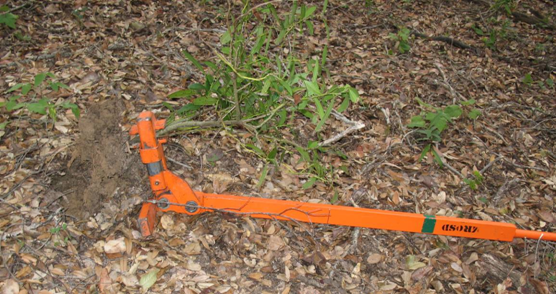
In areas where P. ramorum is present, avoid conducting California bay removal during wet conditions, especially in the spring rainy season.
If you need to remove California bay in winter or spring, do it after an extended period of dry weather and observe stringent sanitation procedures.
The optimal time for California bay removal operations is between late spring, after rains have stopped and the surface soil has dried out, and late fall, before the soil has become wet. During these periods, it is unlikely that viable spores would be dispersed and cut foliage will dry out relatively quickly.
In areas where P. ramorum is not present, avoid California bay removal during wet conditions or when soil is muddy. Follow strict sanitation protocols (see 3.1. Excluding P. ramorum From Non-Infested Areas) to ensure that all vehicles and equipment used are free of contamination before entering the site.
Small California bays in the understory are relatively easy to remove with hand tools. Seedlings up to about 2.5 cm (about 1 inch) DBH can be pulled out using a Weed Wrench™ (fig. 3-3). Seedlings (<1 cm basal diameter) can often be pulled by hand or can be chopped out below the soil surface with a mattock. Removal is easier if the soil is somewhat moist. Small seedlings may also be cut off with loppers or a brush cutter, but cut seedlings can resprout, so repeated cutting may be necessary.
California bay wood is relatively light, so small stems are relatively easy to cut and handle using small chainsaws or hand saws. In contrast, removing large California bay trees requires much greater effort and is more hazardous. Felling large California bay trees requires trained and experienced personnel with proper equipment and safety gear. Crews will need chainsaws, powered or manual pole pruners, and ropes to help guide cut stems. Felled California bays may hang up in the canopies of adjacent trees. Care must also be taken to avoid breaking oak branches when felling California bays. Oak branches or stems with substantial decay are likely to fail when hit by falling California bays. In addition, decayed branches or stems of oaks may fail during or after removal of a California bay which had been supporting the oak.

Figure 3-3—A Weed Wrench™ can be used to pull out bay seedlings that are too large to pull by hand.